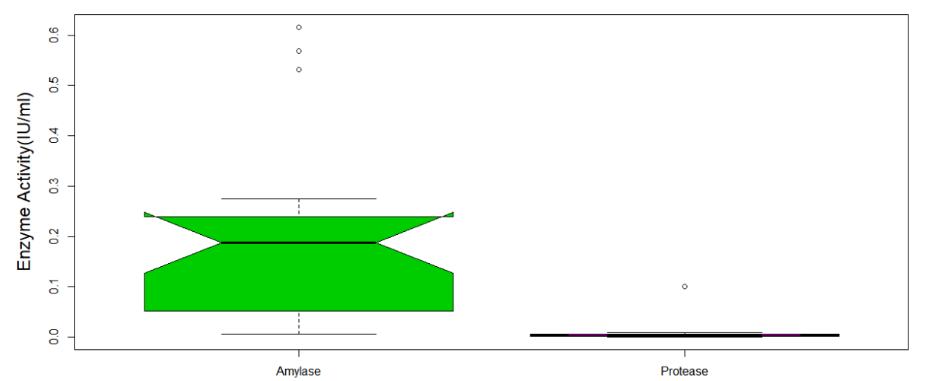Empirical analysis of amylolytic and proteolytic activities of microbial isolates recovered from deteriorating painted wall surfaces in Lagos Nigeria
Main Article Content
Abstract
The biodeterioration of painted walls have been associated with several biological mechanisms such as organic acid production and enzymatic activity of microorganisms amongst other factors. Therefore, this study aims to reveal the involvement of amylases and proteases from indigenous microbes on biodeteriorating painted walls. Microbial strains isolated from biodeteriorating painted walls of selected buildings in Lag os, Nigeria and previously characterized as belonging to the genera Pseudomonas, Candida, Fusarium, Aspergillus, Cerrena and Meyerozyma were used in this study. Amylolytic and proteolytic activities at varying conditions of temperature, pH, incubation time and substrate concentrations were tested. To bridge the knowledge gaps regarding statistical quantification of enzymatic mechanisms in biodeterioration, the Wilcoxon signed rank sum test was used to test the hypothesis that amylolytic/proteolytic activities are equal at all conditions tested. The conditions for optimal activity were observed to be 24h, 37oC, pH 2 and 0.01% substrate concentration and 48h, 25oC, pH 2, and 1% substrate concentration for amylase and protease respectively. Wilcoxon signed rank test revealed that amylolytic and proteolytic activities do not impact aesthetics on painted walls equally at all environmental conditions considered.
Downloads
Article Details

This work is licensed under a Creative Commons Attribution-NonCommercial-NoDerivatives 4.0 International License.
References
Allsopp D, Seal KJ, Gaylarde CC. 2003.Introduction to Biodeterioration,pp. 103-106. 2nd ed. Cambridge: Cambridge University
Press, Cambridge.
Akpan I, Bankole M. and Adesemowo A.A. (1990a). Rapid plate culture method for screening of amylase producing microorganisms. Biotechnology Techniques 13:411-413. doi.org/10.1023/A:1008965808641.
Arti, G., Neelam, G. and Dinesh R. (2010). Optimization of α-amylase production from free and immobilized cells of
Aspergillus niger. Journal of Biotechnology and Pharmaceutical Research1: 001-008.
Awe, O. O. and Gil-Alana, L.A. (2021) Fractional integration analysis of precipitation dynamics: empirical insights from Nigeria, Tellus A: Dynamic Meteorology andOceanography, 73:1, 1-9.
Bernfeld P. (1995). Amylases: alpha and beta methods. Enzymology 1: 149-158.
Biesebeke R, Boussier A, Van Biezen N., Van Den Hondel, C.A.M.J.J. and Punt, P. J. (2006). Identification of secreted proteins of Aspergillus oryzae associated with growth on solid cereal substrates. Journal of Biotechnology 24: 482-485.
Cappitelli F. and Sorlini C. (2005). From papyrus to compact disc: the microbial deterioration of documentary heritage. Critical Reviews in
Microbiology 31: 1–10.
Chopra A, and Mathur D. (1985). Purification and Characterization of Heat-Stable Proteases from Bacillus stearothermophilus RM-67. Journal of Dairy Science 68: 3202-3211.
Da Silva, V. (2003). Microbial deterioration of paints. Microbiologist4: 43. Gaylarde, C. C, and Morton, L. H. G. (2001). Slimes in biodeterioration. Culture22: 1-4.
Gupta, R., Beg, Q. and Lorenz P. (2002).Bacterial alkaline proteases: molecular approaches and industrial applications. Applied Microbiology and Biotechnology 59: 15-20.
Gupta, A., Roy, I.,Patel, R. K, Singh, S.P., Khare, S.K. and Gupta, M. N. (2005). Onestep purification and characterization of an alkaline.protease from halophilic alkalophilic Bacillus sp. Journal of Chromatography 1075: 103-108
Hooper, N. M. (2002). Proteases in Biology and Medicine. London: Portland Press; ISBN 1-85578, 147-6.
Koel S, Sujan M. and Sudeshna R. (2014).Optimization of amylase production from B. Amyloliquefaciens (MTCC 1270) using solid state fermentation.International Journal of Microbiology Article ID 764046, 7 pages http://dx.doi.org/10.1155/2014/764046
Mitchell, D. A. and Lonsane, B.K. (1990). Definition, characterization and economic evaluation. General Principles of Solid Substrate
Fermentation. UK, Rapid Publications of Oxford Ltd.
Obidi, O. F, Aboaba, O. O. and Makanjuola, M. S. (2009a). Microbial Evaluation andDeterioration of Paints and Paint Products. Journal of Environmental Biology 30(5): 835-840.
Obidi O. F .and Okekunjo F. O. (2017). Bacterial and Fungal Biodeterioration of Discolored Building Paints in Lagos, Nigeria. World Journal of Microbiology and Biotechnology 33(11):1- 9 196 doi:10.1007/s11274-017-2362.
Peris-Vicente J, Simó-Alfonso E. and Gimeno, A. J. V.(2005). Direct infusion massspectrometry as a fingerprint of protein-binding media used in works of art. Rapid Commun Mass Spectrom 19: 3463–3467. doi:10.1002/rcm.2217
Priyanka P, Shreya S. and Anushka D. (2015). Isolation and Characterization of Protease Producing Bacteria from Rhizosphere Soil and Optimization of Protease Production Parameters.International Journal of Current Microbiology and Applied Science.2: 58-64.
Raini K, Kant S. and Goyal S. (2016). To study washing efficacy of menhdi, aalta, dry sindoor, wet sindoor stained fabric with different emulsifiers mediated pearl millet amylase bound BSAnanoparticles as detergent-additives. European Journal of Biomedical and
Pharmaceutical Science 3: 202-207.
Ravi, E.V. and Divakar, G. (2013). Production of amylase by using Pseudomonas aeruginosa isolated from garden soil. International Journal of Advances in Pharmacy, Biology and Chemistry 2(1): 50-56
Ravikumar, H.R., Rao, S.S. and Karigar, C.S. (2012). Biodegradation of paints: a current status. Indian Journal of Science and Technology 5(1): 1977- 1987.doi.org/10.17485/ijst/2012/v5i1/30969.
Rojas, J.A., Cruz, C., Mikan, J.F., Villalba, L.S., Cepero de Garcia, M.C. and Restrepo, S. (2008). Isoenzyme characterization of proteases and
amylases and partial purification of proteases from filamentous fungi causing biodeterioration of industrial paper. International Biodeterioration and Biodegradation 63(2): 169–175. doi:10.1016/j.ibiod.2008.07.009
Rojas, T.I, Aira, M. J, Batista, A, Cruz, I. L. and Gonzalez, S.(2012). Fungal biodeterioration in historic buildings of Havana (Cuba). Grana 51: 44-51.doi.org/10.1080/00173134.2011.643920
Sharma, K. M, Kumar, R., Panwar, S. and Kumar, A. (2017). Microbial alkaline proteases: Optimization of production parameters and their properties. Journal of Genetic Engineering and Biotechnology doi.org/10.1016/j.jgeb.2017.02.001.
Shivaramakrishnan S, Gangadharan D, Nampoothiri M, Soccol, C. and Pandey, A. (2006). a- Amylases from Microbial Sources. Food Technology and Biotechnology 44 (2): 173–184.
Singh P. and Kumari P. (2016). Isolation and characterization of amylase producing Bacillus spp. From selected soil sample. International Journal of Research in Bioscience 5(2): 24-29.
Teyjgeler, R. (2001). Preservation of Archives in Tropical Climates. Int Council Archives.doi:10.13140/2.1.2285.9849.
Wahlstron, R. M, Suurnakki A. (2015). Enzymatic hydrolysis of lignocellulose polysaccharide in the presence of ionic liquids. Green Chemistry 17: 694-714.


